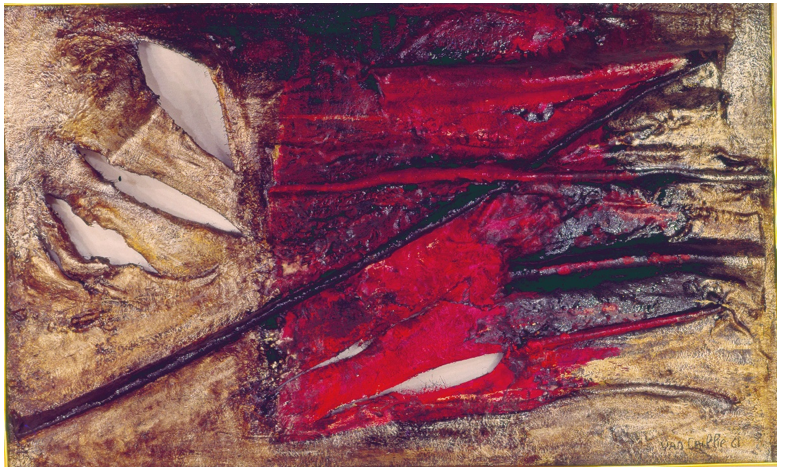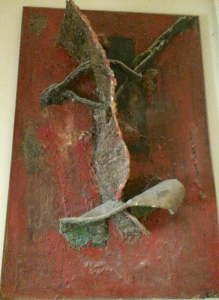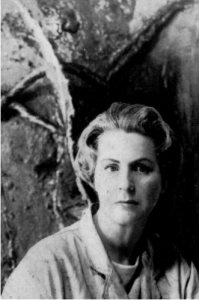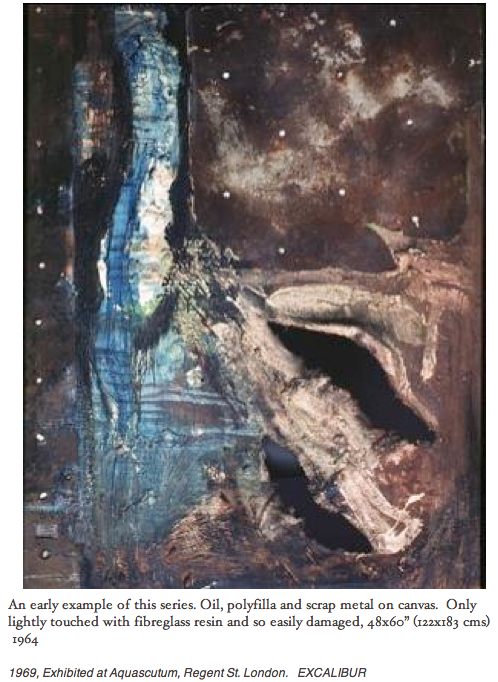Perhaps related, some critics saw, but did not express, an underlying powerful feminism in her work of brooding power and intensity and inspired one (female) critic to write in 1961 ”Overwhelming and unreasonably brutal”, which Marcelle took as a compliment. Beth Elliott examines this further.
From Beth Elliott, Author and musician/songwriter.
Author and musician/songwriter.
 I absolutely agree with your comment that the A La Recherché D’Adam on the first page (205 x 132 cm), “It is doubtful that this picture could have been done by a man”. It is something powerful. There’s something very blood-like to me in the red, neither menstrual nor specifically the result of violence (though it could be), that is very matter-of-fact in a “blood and the peeling back of layers of the body happen, this is life, this is
I absolutely agree with your comment that the A La Recherché D’Adam on the first page (205 x 132 cm), “It is doubtful that this picture could have been done by a man”. It is something powerful. There’s something very blood-like to me in the red, neither menstrual nor specifically the result of violence (though it could be), that is very matter-of-fact in a “blood and the peeling back of layers of the body happen, this is life, this is  natural” kind of way. I can’t quite articulate it, but somehow it speaks to me of a woman’s unflinching awareness of all of the business of blood. Blood, but life continues.
natural” kind of way. I can’t quite articulate it, but somehow it speaks to me of a woman’s unflinching awareness of all of the business of blood. Blood, but life continues.
“Overwhelming and unreasonably brutal.” Apollo 1961 I don’t know that “brutal” is the word; some of her pieces strike me as being very chthonic, with the raw power of roots and rootedness, roots that support very large living structures that insist upon people getting out of their way. The structured piece at the bottom of the first page, the one of the three there without openings, is just such a piece. I don’t think it’s the same one as the one behind her in the first photo on the page, but it has the same kind of power. I have no idea what the leading gallery owner meant when he said “I don’t like all this in front but I like the background.”
 I look at the photo, and I see Marcelle looking like a lioness who’s just made good work of a meaty critter and whose expression is “What? That was just eating lunch.” It’s a powerful piece, indeed, and yet it seems it’s just her expressing herself, without making any statement about the power she can put into a work.
I look at the photo, and I see Marcelle looking like a lioness who’s just made good work of a meaty critter and whose expression is “What? That was just eating lunch.” It’s a powerful piece, indeed, and yet it seems it’s just her expressing herself, without making any statement about the power she can put into a work.
Her work is strong, and yet the brown and blue 1964 piece exhibited at Aquascutum in 1969 is like an ethereal maiden swinging on the crescent moon.  Still, her posture, while not in exactly the same angle, is reminiscent of that “roots”-like piece at the bottom of the page. Perhaps there’s a power in both with no need to announce its power, and perhaps that’s what upsets some viewers. And yet, I think that’s very much a woman’s use of power. No talk, just creation.
Still, her posture, while not in exactly the same angle, is reminiscent of that “roots”-like piece at the bottom of the page. Perhaps there’s a power in both with no need to announce its power, and perhaps that’s what upsets some viewers. And yet, I think that’s very much a woman’s use of power. No talk, just creation.
The holes seem just right to me, too. I don’t see them as making a statement, which is something I’d expect from a male artist or a woman trying to show she can do non-“dainty” work with the “big boys.” It seems to me Marcelle’s vision was not going to be bound by the stretchers, but she wasn’t in a battle with them. I get the sense she just made her art, and part of her vision was dimensionality. Rather than violence or brutality, I just see strength making a canvas something more than what it is. She determines the physicality of the space for her art. Again, because it’s art, and not a statement that the artist is making art and thereby asserting self/ego, I think it’s very much a woman’s way of being powerful. She wrote that there was a part of herself in her pictures.
Marcelle also wrote that she did not see her pictures as brutal but as victims. The holes she opens in her surfaces can be seen as wounds, in a positive way. They are wounds that instead of killing, damaging or weakening her surfaces, allow more inspiration and intuited content to emerge. A key Western archetype relating to wounds and wounding is, of course, the Grail legend of the king with the wound that will not heal. Until the question of what this is and what it means is answered, the kingdom is a wasteland. An alternative take on this comes from viewing the Grail as menstrual imagery (per Shuttle and Redgrave’s “The Wise Wound,” happily back in print), in which the wound that will not heal also will not kill, but rather convey wisdom from the individual subconscious and collective unconscious. Either take is very powerful, and this may explain some of the very visceral reactions to van Callie’s work, both positive and negative.
But not only do wounds appear, her surfaces build up, as though the constant destructive-creative forces of Nature are at work. In nature, as in van Callie’s works, this is a relentless and powerful process of change and transformation that proceeds without regard for the human gaze. Van Callie destroys the two-dimensionality of her surfaces, and in that process unleashes a powerful creative force that builds up texture on her surfaces. No wonder some find her three-dimensional work disturbing. That men and women might have very divergent reactions to her work is quite understandable.
( Chthonic, of or relating to earth, particularly the Underworld. Chthonic figures in Greek mythology included Hades and Persephone, the rulers of the Underworld, and the various heroes venerated after death; even Zeus, the king of the sky, had earthly association. `En britannica).
Beth later wrote (2016)
“As someone sees van Callie’s unrestrained convex and concave transformations of her canvases as something intensely physical but not violent, it never occurred to me that others might find any of them disturbing, or that reactions to them might be gendered. Some I find sufficiently intense as to possibly take one aback, but, as I’ve said, I find it a chthonic intensity, and that is raw power more than violence.
Once that notion was broached, though, my thoughts turned immediately to the deep psychology of blood in the Grail legend. This is in the sense of Jung as explored by Joseph Campbell (though I’m much more of an Erich Neumann fan) rather than the mistake of trying to pigeonhole van Callie into becoming a “feminist” artist. We have Judy Chicago, and her powerful installment The Dinner Party, to occupy that niche.
In my (currently e-book only) Redemption Through Love! An irreverent guide to getting Wagnerian opera thrills without being a nut, the chapter on Parsifal has a few things to say about the elided sexual content of the story of the Grail and the wounded King. From this passage, I’ve redacted the discussion of Hyam Maccoby’s The Myth Maker: Paul and the Invention of Christianity, which is more relevant to Wagner’s vision of a Christianity that would greatly Buddhist and much, much less Jewish. Perhaps this may shed some light on how some have found van Callie’s art a tad intimidating.
What we have in Parsifal, then, is a straightforward story with a reasonably straightforward allegorical meaning made accessible by the music and the occasional “voice from above.” Meanwhile, there’s plenty of background material underlying Parsifal into which to sink one’s teeth.
In particular, we have the whole wounded Grail king motif. Though Amfortas’ “wound which will not heal” is in his side, the original version of the legend places the wound in his “thigh.” And yes, that actually means his genitals. The king is supposed to guarantee the fertility of the land; since he can’t, the land has become a wasteland (the famous T.S. Eliot poem riffs on this). The rituals that sustain the natural order are repeated—with blood dripping off the lance into a cup—as the wounded king awaits someone to come along and ask what it all means.
Technically, there are three questions: Whom does the Grail serve? The world is in the Grail and the Grail is in the world—what is the Grail? And, Where is the Grail castle, that is surrounded with water, that is everywhere at once, and which is invisible? This takes a long time to get asked, because either a Knight of the Round Table comes along and is so in awe of the scene that he gets tongue-tied, or everyone’s so wrapped up in the entire matter, on which their well-being depends, that it takes a fool to stumble along and blurt out the questions.
All this blood in a cup that fills and refills … and a lance dripping into the cup … Wolfram von Eschenbach hinted broadly about the Grail blood being the blood of sexuality, related to the rhythms of the sun and moon. There is a precursor in the Biblical Song of Songs, in the deep round bowl of … well, it gets cleaned up into her “navel” when it’s so obviously a woman’s pelvic basin. As a counterpart to the Grail King’s wound that will not heal, we have in the womb symbol bleeding that is not an injury, bleeding that is about renewal rather than the loss of the life force: the wise wound. And that just happens to be the title of a 1978 book by Penelope Shuttle and Peter Redgrove researched and written to make up for the lack of any substantive writing on the subject of menstruation. The Grail? It’s the womb. Its use? The menstrual cycle is a feedback loop that links the body’s roots and the mind, so it serves women and, by extension, all of us. Women walk around, so this Grail is everywhere and yet invisible.
Meanwhile, though, we have a counterpart to Amfortas’ wound in Klingsor’s self-inflicted castration wound, which is in the true location of the wound of the Grail King, or Fisher King. The earliest myths call him the Fisher King because he can no longer bring procreative energy to the land, but just go fishing. Ironically, this ties into Wagner’s notion that Christianity had gotten too “Jewish,” and in a proper Ayran manifestation would be more Buddhist—meaning about compassion. (And so we get Wagner’s Parsifal, who restores the Grail Kingdom as the only one who can: “a fool made wise by compassion.”) You see, some key Christian church fathers, Augustine in particular, felt “betrayed by their bodies” tempting them into sexual sin. Augustine asked to be made chaste—“but not yet.” Origen did castrate himself to stop feeling horny. Paul—well, there’s conjecture as to whether he was merely celibate or an actual “eunuch for the sake of the Kingdom of Heaven.” There’s also conjecture as to whether “eunuch” in this context meant someone whose testicles or testicles and penis had been removed, per the Greek root of the word, or merely someone incapable of or disinclined toward marriage and reproduction.
Shuttle and Redgrove trace the Grail legend to its origins in the Celtic Cauldron of Cerridwen (pronounced Kair-ID-wen), Cerridwen being one of those dark terrible mothers who welcomes the dying but in whose cauldron (womb) they are regenerated and from it they are reborn. They found part of the Grail legend that refers to its containing two kinds of wine, red and wine, and related that to menstrual blood and sexual arousal secretions. Being (or becoming) good Jungians, they uncovered even more symbolism: They found the symbol of the Tree of Life in the pathways that open in the cervical mucus at ovulation, and found that all those special places touted as the “navel of the world” really had to be the “cervix of the world”: the all-seeing single eye (as on the dollar bill), the vortex through which we move between worlds at birth, the door between rational consciousness and the intuitive consciousness of the subconscious, and such.
In addition to the benefits of easier periods gained by using menstruation as a body-mind feedback loop, Shuttle and Redgrove found potential for psychic integration and wholeness through exploring the experience rather than dreading it. Specifically, in this regard, they quoted Emma Rauschenbach Jung’s (1882-1955) great study, The Grail Legend, completed by Marie-Louise von Franz (1915-1998) after Jung’s death. Jung and von Franz approached the Grail-as-womb-symbol as a feminine krater, or (ancient Greek) vessel of spiritual transformation. They wrote:
“When a myth is enacted in a ritual performance or, in a more general, simpler and profaner fashion, when a fairy tale is told, the healing factor within it acts on whoever has taken an interest in it and allowed himself to be moved by it in such a way that through this participation he will be brought in connection with the archetypal form of the situation and by this means enabled to put himself ‘into order.’”
Myth enacted in ritual performance? Sounds pretty Wagnerian, doesn’t it? Here’s Shuttle and Redgrove’s take:
“The woman goes on her night sea journey through whatever her individual menstruation reveals to her of pain or vision; and often, with the flow of blood, there is a renewal of feeling: the hero (hera) emerges. This is the cycle of individuation or of ‘integration of her rhythms’ that a woman goes through each month and in which she learns, if she will, all that can be learned. The hero, the man, can be her companion, as child or adult, who learns what as a man he cannot directly know, but yet which is true, from the woman’s changes.”
Shuttle and Redgrove came up with another answer to the question of what is the Grail for in humans’ evolution from an estrus cycle to a menstrual cycle: it favored the development of social and economic cooperation in early hominids, which worked well for both hunter-gatherers and the farmers who settled down and started towns and civilizations during the favorable agricultural conditions of the Bronze Age Climate.
Book excerpt copyright © Beth Elliott 2013